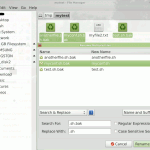Mass renaming files is no possible with the standard linux command mv, but it’s possible to achieve this goal in many different ways, from some bash magic, to programs that do exactly this, in this article I’ll work with both the terminal and with graphical tools.
Mass renaming files on Linux
- 12/22/2012
- Mass renaming files on Linux
- Posted by Riccardo at 20:46
- 4 Responses
- Guides
- Tagged with: filenames, linux, linux command, multiple files, perl script, regular expression, rename mass files, renaming files, target names, terminal, thunar

